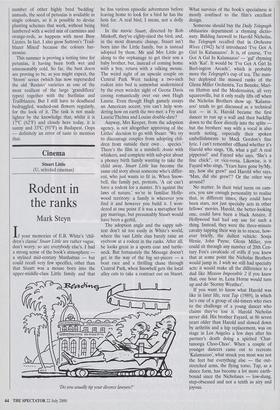Cinema
Stuart Little
(U, selected cinemas)
Rodent in the ranks
Mark Steyn
If your memories of E.B. White's 'chil- dren's classic' Stuart Little are rather vague, don't worry: so are everybody else's. I had a strong sense of the book's atmosphere a stylised mid-century Manhattan — but could recall very few specifics, other than that Stuart was a mouse born into the upper-middle-class Little family and that he has various episodic adventures before leaving home to look for a bird he has the hots for. A real bird, I mean, not a dolly bird.
In the movie Stuart, directed by Rob Minkoff, they've eighty-sixed the bird, and, in the most dramatic change, Stuart isn't born into the Little family, but is instead adopted by them. Mr and Mrs Little go along to the orphanage to get their son a baby brother, but, instead of coming home with a boy, return with a talking mouse. The weird sight of an upscale couple on Central Park West tucking a two-inch rodent into bed is somewhat undermined by the even weirder sight of Geena Davis cooing romantically over our own Hugh Laurie. Even though Hugh gamely essays an American accent, you can't help won- dering how on earth the two met: a Fry and Laurie/Thelma and Louise double-date?
Anyway, Mrs Keeper, from the adoption agency, is not altogether approving of the Littles' decision to go with Stuart: 'We try to discourage couples from adopting chil- dren from outside their own . . . species.' There's the film in a nutshell: Annie with whiskers, and complete with sub-plot about a phoney birth family wanting to take the child away. Stuart Little has become the same old story about someone who's differ- ent, who just wants to fit in. When Snow- bell, the family pet, protests, 'A cat can't have a rodent for a master. It's against the laws of nature,' we're in familiar Holly- wood territory: a family is wherever you find it and however you build it. I won- dered at one point if it was a metaphor for gay marriage, but presumably Stuart would have been a gerbil.
The adoption angle and the sappy sub- text don't sit too easily in White's world, where the vast Little clan barely raise an eyebrow at a rodent in the ranks. After all, he looks great in a sports coat and turtle- neck. But fortunately the Message doesn't get in the way of the big set-pieces — a boat race and a thrilling chase through Central Park, when Snowbell gets the local alley cats to take a contract out on Stuart.
Do you usually tip your divorce lawyers?' What survives of the book's specialness is mostly confined to the film's excellent design.
Someone should buy the Daily Telegraph obituaries department a rhyming dictio- nary. Bidding farewell to Harold Nicholas, the Telegraph recalled that in Orchestra Wives (1942) he'd introduced 'I've Got A Girl In Kalamazoo'. It is, of course, 'I've Got A Gal In Kalamazoo' — 'gal' rhyming with 'Kan It would be 'I've Got A Girl In Burl-ington Arcade', which is probably more the Telegraph's cup of tea. The num- ber deployed the massed ranks of the Glenn Miller Orchestra, Tex Beneke, Mari- on Hutton and the Modemaires, all very squaresville, but it only really lifts off when the Nicholas Brothers show up. 'Kalama- zoo' tends to get discussed as a technical feat — in it, Harold became the first dancer to run up a wall and then backflip down to the floor directly into the splits but the brothers' way with a vocal is also worth noting, especially their spoken embellishments to Mack Gordon's fine lyric. I can't remember offhand whether it's Harold who sings, 'Oh, what a gal! A real pipperool' and Fayard who says, 'She's a fine chick!', or vice-versa. Likewise, is it Fayard who sings, 'Years have gone by/My, my, how she grew!' and Harold who says, `Man, did she grew!'? Or the other way around?
No matter. In their brief turns on cam- era, you saw enough personality to realise that, in different times, they could have been stars, not just specialty acts in other fellows' movies. Harold, the better-looking one, could have been a black Astaire, if Hollywood had had any use for such a thing. Instead, they were the three-minute cavalry tapping their way in to rescue, how- ever briefly, the dullest vehicle: Sonja Henie, John Payne, Glenn Miller, you could sit through any number of 20th Cen- tury Fox's cavalcade of stiffs if you knew that at some point the Nicholas Brothers would jump in. I wish we still had specialty acts: it would make all the difference to a dud like Mission Impossible 2 if you knew that, one hour in, Lena Home would turn up and do 'Stormy Weather'.
If you want to know what Harold was like in later life, rent Tap (1989), in which he's one of a group of old-timers who rises to the challenge of a young dancer who claims they've lost it. Harold Nicholas never did. His brother Fayard, at 86 seven years older than Harold and slowed down by arthritis and a hip replacement, was on stage in Los Angeles a few days after his partner's death doing a spirited 'Chat- tanooga Choo-Choo'. When a couple of younger dancers came out to recreate `Kalamazoo', what struck you most was not the feet but everything else — the out- stretched arms, the flying torso. Tap, as a dance form, has become a lot more earth- bound since the Nicholases — low-slung, step-obsessed and not a tenth as airy and joyous.


























































 Previous page
Previous page